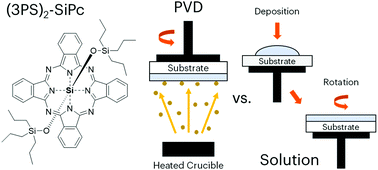Highlighting the processing versatility of a silicon phthalocyanine derivative for organic thin-film transistors†
Abstract
Silicon phthalocyanine (SiPc) derivatives have recently emerged as promising materials for n-type organic thin-film transistors (OTFTs) with the ability to be fabricated either by solid state or solution processes through axial functionalization. Among those, bis(tri-n-propylsilyl oxide) SiPc ((3PS)2-SiPc) is unique as it can be processed by sublimation, while being soluble enough for solution processing. In this work, the charge transport properties of (3PS)2-SiPc and its polymorphic forms were studied through Kinetic Monte Carlo (KMC) simulations and density functional theory (DFT) calculations along with the characterization of (3PS)2-SiPc in n-type OTFTs fabricated by physical vapour deposition (PVD) and spin coating. Post-deposition thin-film characterization by X-ray diffraction (XRD), atomic force microscopy (AFM), and scanning transmission X-ray microscopy (STXM) was used to assess film morphology and microstructure in relation to the electrical performance of OTFTs. The differences in film formation by PVD and solution fabrication had little effect on OTFT performance with comparable field-effect mobility and threshold voltage ranging between 0.01–0.04 cm2 V−1 s−1 and 18–36 V respectively. Consistent charge transport properties of (3PS)2-SiPc OTFTs achieved at different fabrication conditions highlights the processing versatility of this material.



 Please wait while we load your content...
Please wait while we load your content...